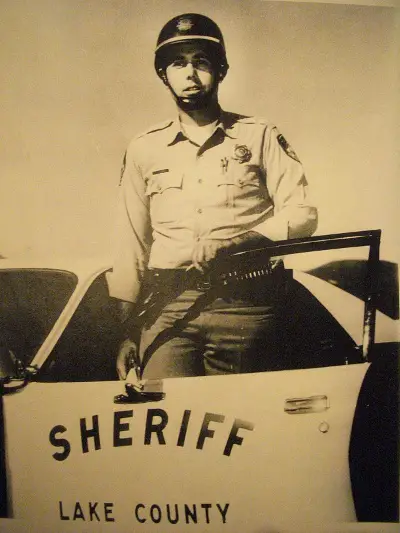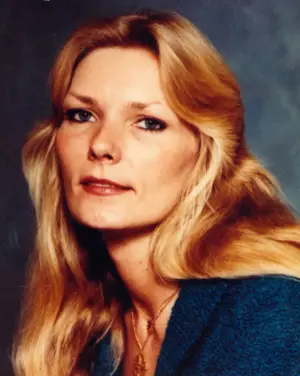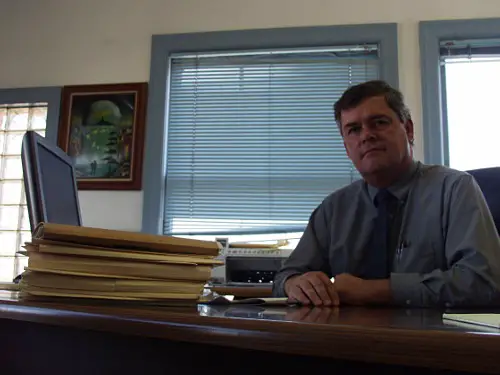
LAKE COUNTY – A woman who pleaded guilty to the 1981 murder of a Lake County Sheriff's sergeant has been sent back to her home country of Sweden.
Annika Ostberg Deasy, 55, arrived in Sweden early Wednesday morning after leaving California on Monday.
She has served 27 years in prison for the May 1981 murder of Sgt. Richard Helbush, a 13-year veteran of the Lake County Sheriff's Office, and the murder days earlier of Stockton restaurateur Joe Torre.
California Department of Corrections and Rehabilitation spokesperson Terry Thornton told Lake County News on Tuesday that Deasy was transferred from the California Institution for Women in Chino to federal authority on March 25. Thornton would offer no further details on the case.
Sheriff Rod Mitchell called Deasy's release “outrageous.”
“I just would never have believed that this would happen,” said Mitchell.
District Attorney Jon Hopkins, who has attended Deasy's parole hearings to speak against her release, was equally astonished by the news.
Both Hopkins and Mitchell said they were essentially cut off by state and federal officials who considered the transfer, and that their inquiries and concerns about sending Deasy back to Sweden were ignored.
Deasy was released back to Sweden under the auspices of the US Department of Justice's International Transfer Unit, which did not respond to Lake County News' request Tuesday for comment on the transfer.
When Lake County News contacted the agency in recent weeks to ask questions about its consideration of Deasy's transfer, a spokesperson said they do not discuss specific cases. Federal law grants the prisoners privacy rights.
Swedish prison officials flew Deasy to Sweden on a private chartered jet that cost the Swedish government $62,000, according to The Local, a Swedish publication.
When contacted by Lake County News on Tuesday, the Swedish Foreign Ministry Office in Stockholm said they could not offer comment on Deasy's case. An official said that the Swedish Ministry of Justice is expected to comment on the case at some point.
Martin Valfridsson, press secretary to Swedish Minister for Justice Beatrice Ask, told Lake County News early Wednesday morning that Deasy had landed in Sweden earlier in the morning aboard the chartered jet.
Valfridsson said she is being held at the Hinseberg prison, the most highly secured Swedish prison for women.
1981 murders led to prison sentence
Deasy and her boyfriend, William “Bob” Cox, met Stockton restaurateur Joe Torre to sell him some meat in late spring of 1981. Cox and Torre reportedly got into an argument during which it's alleged that Cox shot Torre. It's also been alleged that Deasy may have set up the meeting as a potential robbery. Both she and Cox had growing drug habits, according to the biography on her Web site, www.annikadeasy.org.
Following the shooting, Deasy and Cox traveled to Lake County, where Deasy's son and his father lived, because she said she wanted to see the child.
During their trip through Lake County, their car tire went flat later that night.
Shortly after midnight on May 2, 1981, 34-year-old Sgt. Richard Helbush came upon the two on Manning Flat on Highway 29. He was traveling back from Clearlake to Lakeport, where he was going off duty for the night, according to Don Anderson, a former Lake County Sheriff's deputy who today is a local defense attorney.

When Helbush stopped to help the couple, Cox shot him three times in the back and once in the back of the head. He and Deasy then took Helbush's wallet, service revolver and patrol car, and left Helbush's body on the side of the road, where he was later discovered by fellow deputies, Anderson said.
Later that morning, Anderson, a reserve deputy and an off-duty California Highway Patrol officer would apprehend Cox and Deasy following a car chase and a gun fight on Cobb, during which Cox was wounded several times and Anderson was hit in the leg by bullet fragments.
Cox and Deasy reportedly had a suicide pact, said Anderson. Following the preliminary hearing, Cox – who had done time in Turkish prison on drug charges – hung himself using bed sheets in the Lake County Jail, then located behind the courthouse on N. Forbes, where the District Attorney's Office is located today.
“They made a suicide pact that only he was serious about,” said Anderson.
Deasy would go on to face murder charges herself. “It originally was a death penalty case,” said Anderson.
She pleaded guilty to two charges of first-degree murder for the deaths of Helbush and Torre in a deal with then-District Attorney Steve Hedstrom, said Hopkins. Each charge carried a sentence of 25 years to life.
Process moved quickly
Late in February, Jon Hopkins found out that the California Board of Parole Hearings once again was considering Deasy's request to be returned to Sweden so she could serve out her sentence closer to her family. He sent a letter to the board, voicing his objection to allowing Deasy to return to Sweden.
Hopkin said he had written, called and e-mailed a state Board of Parole Hearings official regarding Deasy's consideration for transfer, and that the man had never returned any of his calls. It's a situation he said he's never encountered as a prosecutor.
His February letter stated that Deasy has been convicted of three separate homicides – Helbush's, Torre's and a 1974 manslaughter conviction for the death of Donald McKay in San Francisco. He alleged that she refused to take responsibility for any of her crimes.
“She has not been found suitable for parole at any of the several Lifer Hearings held over the years,” he wrote. “She has not been found suitable for the International Prison Transfer program, in spite of regular requests to be sent back to Sweden to serve out her sentence.”
Hopkins added, “It is clear that she would be released from custody soon after arriving in Sweden, should she be transferred.”
Deasy has been refused parole four times and transfers to Sweden three times previously, according to Gordon Hinkle, deputy press secretary for the California Department of Corrections and Rehabilitation.
Her most recent denial for parole of transfer had come last September, Hinkle said. He said that hearing was separate from the consideration under the International Prisoner Transfer Program.
Under California Government Code, the governor or his designee – in this case, the executive officer of the Board of Parole Hearings – can give approval to a prisoner transfer to a country which has a treaty with the United States that provides for prisoner transfers.

Hinkle said the criteria for considering a transfer request includes background, history, public safety, and what's in the best interest of the person with respect to rehabilitation and integration.
He said that, while state approval for a prisoner transfer is necessary before the US Department of Justice's review can begin, the process is a federal one.
Late last month Hinkle had confirmed to Lake County News that Deasy was approved for federal review of her request to be transferred to a Swedish prison.
At that point, she had not been approved for transfer, Hinkle said, noting, “She still has to go through several steps.”
But that process, which had just been approved, appeared to already have been well under way, as Deasy was released to federal custody on March 25, within days of Hinkle's comments to Lake County News.
Swedish officials received the agreement from US authorities for Deasy's transfer on March 26, said Valfridsson.
The effort to get Deasy returned to Sweden has been ongoing for a long time, however it had appeared to gain more momentum in recent years.
Swedish Prime Minister Fredrik Reinfeldt met with Gov. Arnold Schwarzenegger in California in May 2007 and discussed Deasy's case.
“He stressed from the Swedish point of view the importance of having a Swedish citizen transported to Sweden,” Valfridsson said.
The following month, Ask took up the matter with then-US Attorney General Alberto Gonzalez. Ask said in a Wednesday statement that those efforts finally had borne fruit.
Valfridsson said Sweden's prison authorities must ultimately make the decision about where Deasy goes next.
Mitchell and Hopkins both are furious over state and local officials' failure to keep them apprised of the situation.
Hopkins said he couldn't believe the state would make a decision about someone convicted of killing a law enforcement officer without having the courtesy to have a conversation of any kind with the prosecution or the agency that lost its sergeant in the line of duty. “It's really got me hot.”
He also was concerned that the basic merits and facts of the case weren't considered. “I think we need a change in how things are done.”
Mitchell said state and federal officials have not been responsive to local concerns. “On so many levels it's horrifying.”
Helbush's family has chosen not to comment publicly on the matter. However, family members have in the past made appearances at Deasy's parole hearings to speak against her release.
Deasy seen as a martyr
“Annika is a person with a history of drug abuse from a young age who lived irresponsibly as a young adult. As such, it would suggest justice was well served; however, nothing is ever as simple on it's surface as it would appear,” says a passage found at her Web site, www.annikadeasy.org.
Deasy moved to the United States from Sweden with her mother when she was 11 years old. The biography on her Web site said she and her mother moved to the US when her mother married a wealthy American businessman, who became a “cold, distant and emotionally abusive stepfather.”
Speaking little English, she soon began having problems, including being picked on by classmates. At the age of 12 she was sent to a youth detention center, and the following year, in the spring of 1967, she ran away to San Francisco with a musician in his 20s. There she later met Greene Johnston, the father of her only child, Sven, and got into drugs and began working as a stripper and prostitute to support herself and her son while still a teenager.
She later married a man named Brian Deasy and moved with him to Stockton, getting off drugs and becoming a housewife. But within a few years her marriage broke up, she returned to drug use and met Cox, a drug dealer with a long criminal record.
Anderson, who has thoroughly studied Deasy's case and even corresponded with her for a time, said in 1974 she admitted killing McKay. There were allegations that another man – an ex-boyfriend – had actually done the killing, but Deasy, who was being investigated for welfare fraud at the time, was convicted, given a suspended sentence and did five years' probation.
In Sweden, where Deasy's case is well known, prison terms aren't as long, and Deasy reportedly wouldn't have faced the murder charges.

Many Swedes also believe Deasy's case illustrates an overly harsh US justice system. Her Web site, noting that she had served longer than even her attorneys had expected, says, “unfortunately she has become a pawn in the misguided agenda of California politics.”
In her home country she's become a celebrity. Hopkins' Feb. 20 letter to the state Board of Parole Hearings noted, “The Swedish media has created a cult following which believes Ms. Deasy is a victim of American justice who has done nothing wrong.”
Anderson said he became friendly with a Swedish filmmaker who invited him to Sweden for a week's stay in 1999 and encouraged Anderson to write a book about his experiences, which he's now finishing.
He called Deasy's popularity in Sweden – where she's had plays, books and countless articles written about her – “remarkable,” adding that she's seen as a martyr.
Her elderly mother, Maj-Britt – who Anderson called “a very nice lady” – has been a very vocal advocate for having Deasy released home to Sweden.
During his visit to Sweden Anderson was surprised to find out how he was viewed by the Swedish public.
“I was portrayed as a ruthless and brutal cop who beat up Annika at the scene,” he said. “I had no clue what they were talking about.”
Following the shootout, Anderson said Deasy went to Cox's side and started feeling around on the ground for his gun.
Anderson said when he got to a point where he could see neither Cox or Deasy had the gun in their hands, he went up, put the barrel of his handgun in Cox's eye sock, used his other hand to grab the back of Deasy's head and shove it in the dirt and stepped on Cox's other hand, holding the two down while the other officers came to help arrest them.
Anderson said he found out later he had pulled a large handful of Deasy's hair out. After he handcuffed her, he had to fight to get Deasy into the patrol car.
He said he didn't brutalize Deasy – who he called “a pretty good-sized woman” – “but I wasn't gentle with her at all.”
Anderson said that, from studying Deasy's defense case in the Helbush prosecution, “She knew exactly what was going to happen,” when Cox sent her to look for his driver's license – which he didn't have – in the car while he spoke with Helbush. She was helping distract Helbush, who Cox then shot.
He said he believes Deasy does take responsibility for what happened, but her position is that she didn't shoot Cox. “She feels she's being punished as if she was the one who pulled the trigger.”
But not everyone is convinced that it was Cox who pulled the trigger. Mitchell, who said he is baffled by Deasy's folk hero status, said he's not entirely convinced that Deasy herself didn't shoot Helbush.
A case of troubling timing
Anderson said Tuesday he also was surprised at how the case was resolved without local input.
He still has strong feelings about the night of Helbush's shooting.
Just before Helbush left to make his fateful drive to Lakeport, the two men had coffee at the firehouse in Clearlake.
“He was a good guy, he really was. He was a friend,” Anderson said of Helbush, remembering him as a very conscientious man who was always smiling.
But Anderson added, “I can see both sides of it. I really can.”
Anderson said one part of him feels Deasy has spent enough time in prison, while the other part of him holds that she took part in killing his friend.
The timing of Deasy's release also is particularly troubling, in light of the recent shooting deaths of four police officers in Oakland and three in Pittsburgh, said Anderson. “Now they're going to let a cop killer go. It's kind of disheartening.”
Both Hopkins and Mitchell agreed.
“My thoughts exactly,” said Hopkins.
E-mail Elizabeth Larson at This email address is being protected from spambots. You need JavaScript enabled to view it..